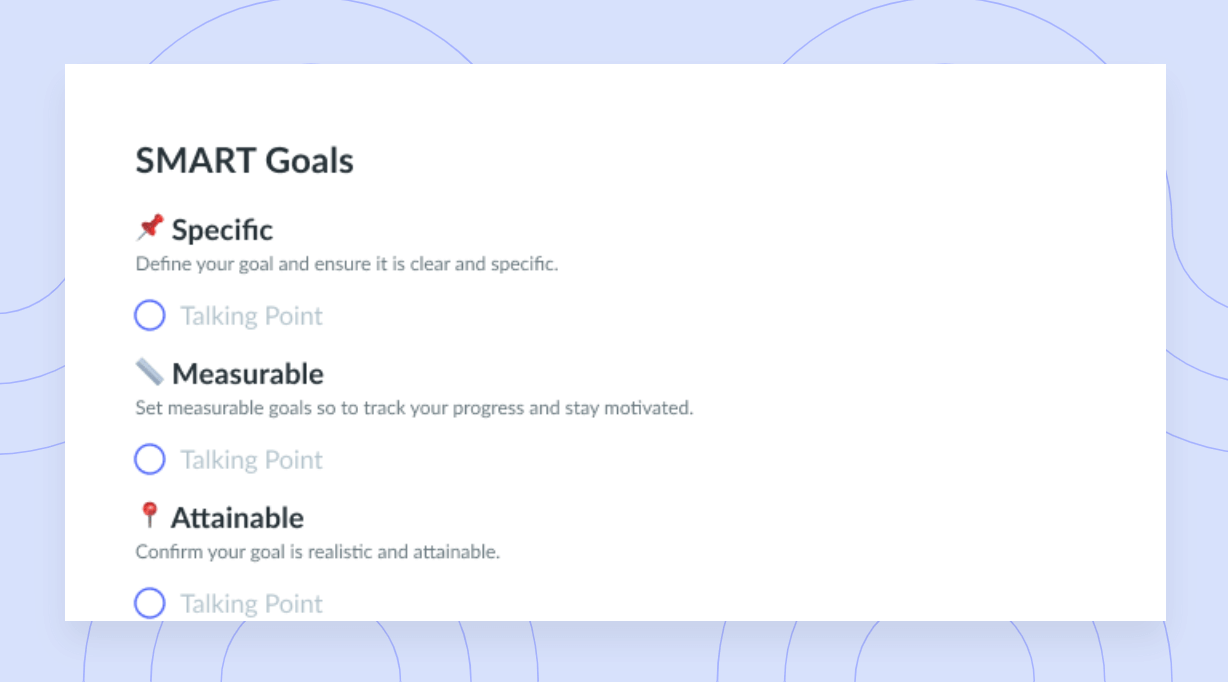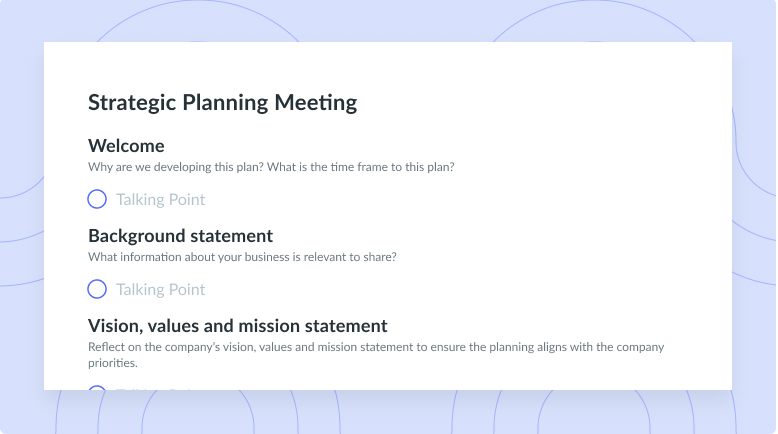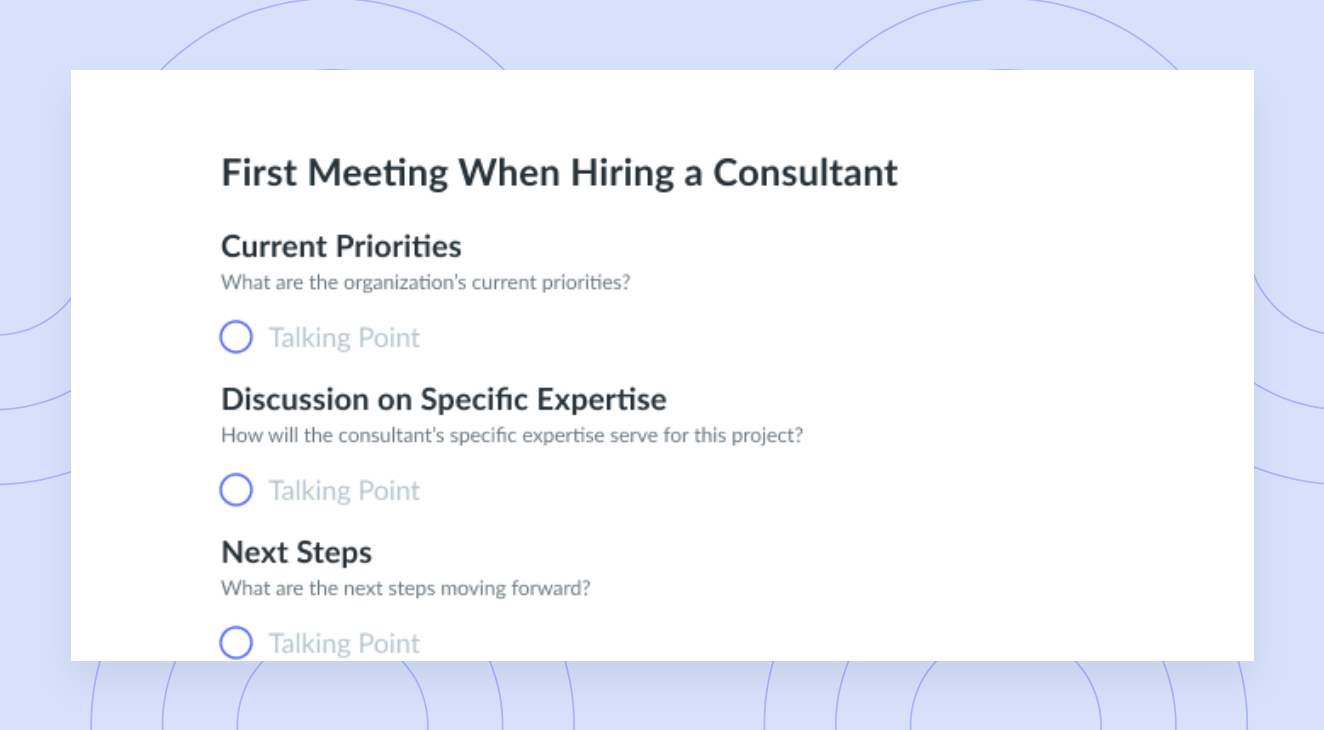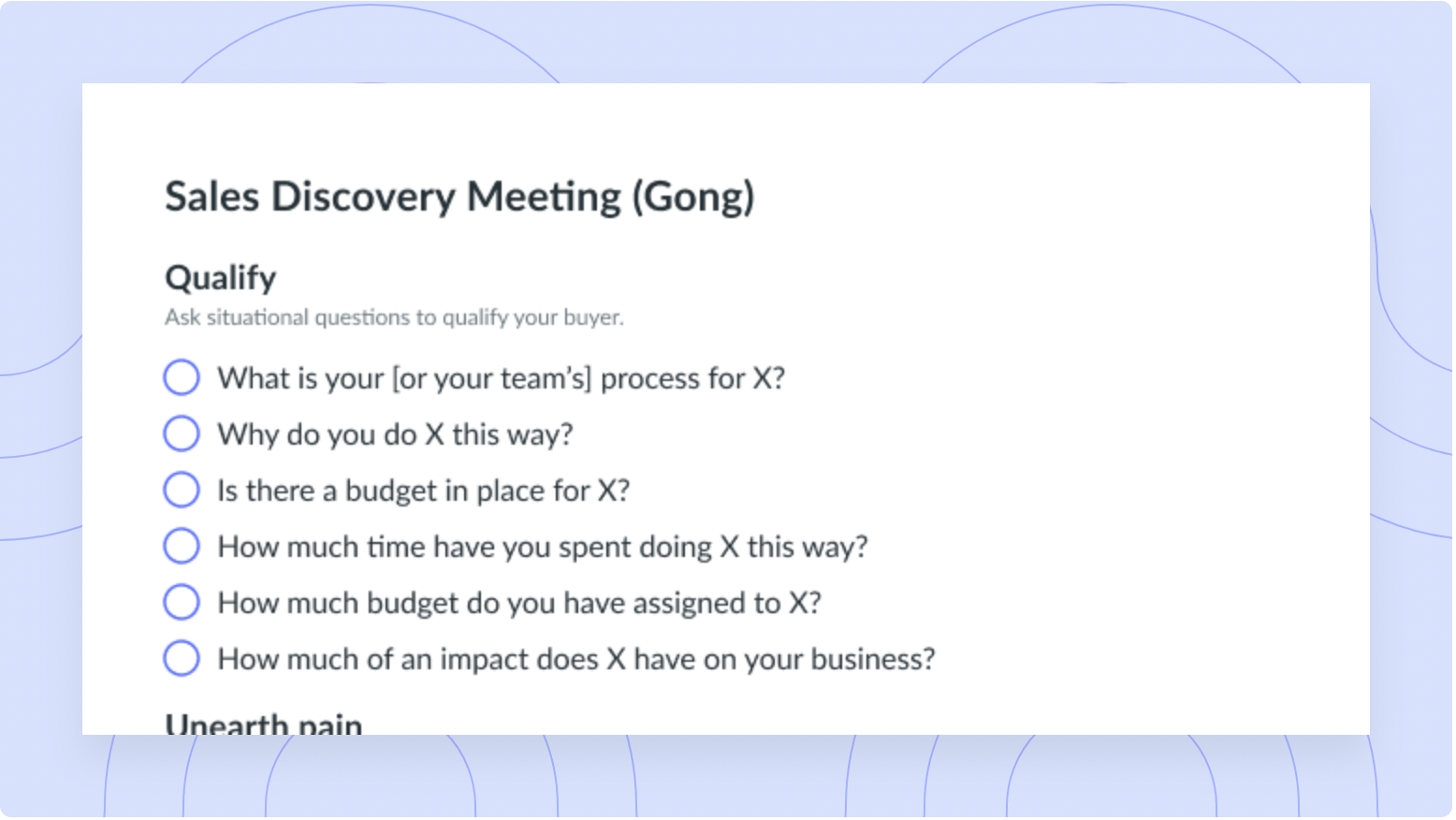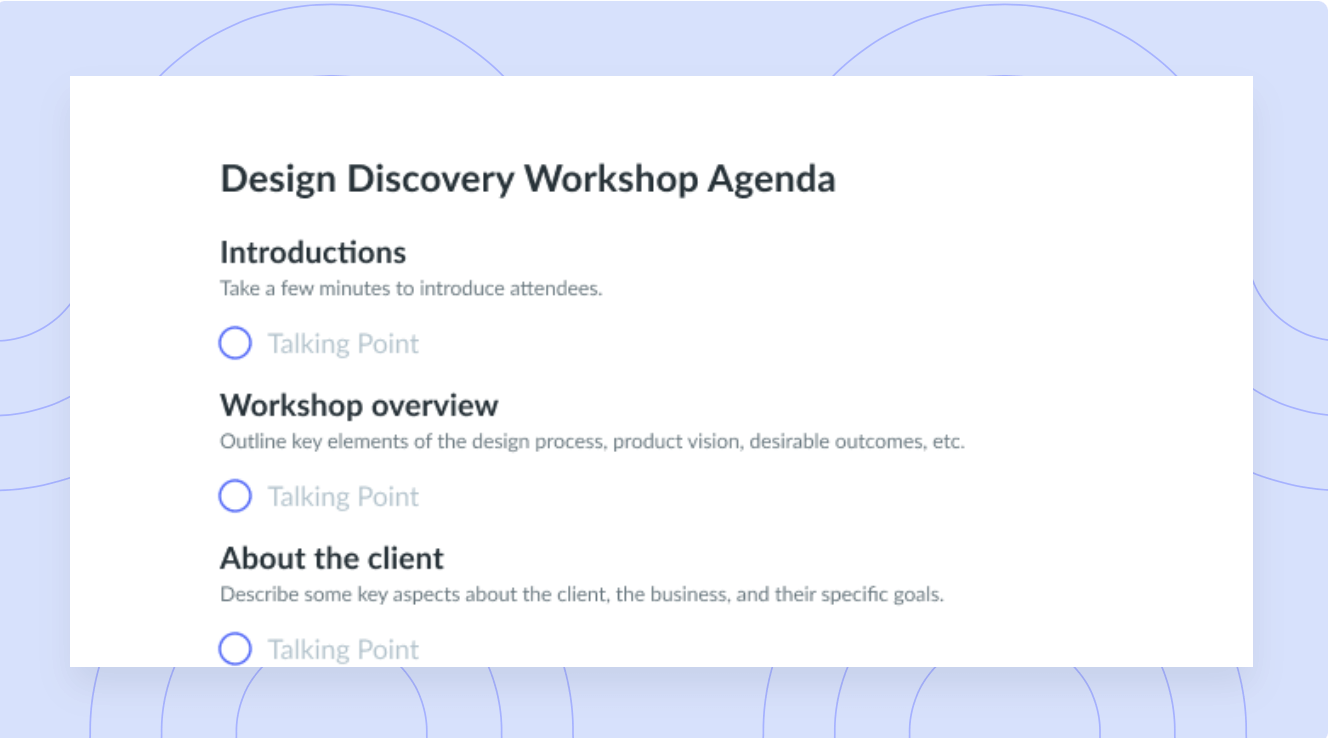How to Create SMART Goals (With Examples)
Create SMART goals for you and your team with our top 4 tips and example goals.
They say that managing a team requires lots of time and patience, and just as importantly, it requires smarts. Not that only a genius can effectively run the show – you just need to know whether your team goals are SMART or ineffective. And we’re not capitalizing “SMART” to make a point – it stands for an incredibly resourceful guide you and your team can use to create and meet meaningful goals.
- What are SMART goals?
- How to write SMART goals
- Examples of SMART goals
- Tips for accomplishing a SMART goal plan
What are SMART goals?
SMART goals are objectives that you can easily define and act upon. They help you figure out the resources you need – including time – to get something done.
The concept of SMART goals dates back to an article titled “There’s a S.M.A.R.T. way to write management’s goals and objectives.” In this article, which first appeared in the November 1981 issue of Management Review, management consultant George T. Doran defined each letter of the acronym:
- S: Specific. Your goal should clearly state the desired outcome and any attendant expectations.
- M: Measurable. You should be able to numerically define your goal and track all progress toward it. If your goal is qualitative, you should develop a way to track it numerically.
- A: Achievable. Over time, the “A” of SMART goals has changed to “achievable,” though Doran initially defined it as “assignable.” For your goal to be achievable, you must be reasonably confident your team can pull it off, given your current available resources.
- R: Relevant. Your goals should pertain to your company’s values and yield a meaningful impact for your business.
- T: Time-bound. Your goals need a target date by which you expect to complete them.

Pro tip
Use a meeting management tool like Fellow to organize and track your goals in a personal or shared stream.

How to write SMART goals
To write business goals that are specific, measurable, achievable, relevant, and time-bound, you should develop your goal one letter at a time. For best goal-setting results, try asking questions for each letter, then answer them. Below, we’ve given you a step-by-step guide on setting SMART goals.
S Specific
To set a specific goal, answer the following questions:
- What exactly are we looking to accomplish?
- Which team members will be involved in accomplishing it?
- How will we accomplish it?
You don’t necessarily need long answers to these questions – just write enough to set the stage. An example might be “Grow our revenue by hiring more employees to develop our product, with CEO and recruiting team involvement.”
M Measurable
Once you’ve determined your goal and figured out the who and how of it all, you should establish a tracking method. Doing so can be simple: Just decide a range of metrics that satisfy your definition of reaching your goal. You can figure out this range by asking yourself:
- In what quantity do we want to achieve this goal?
- What numbers must we reach to feel that we’re making good progress?
To continue the example above, your goal might now be the following. “Grow our revenue by $500,000 by hiring three more employees to develop our product, with CEO and recruiting team involvement.”
A Achievable
The next step as you write SMART goals is to figure out whether you can realistically reach your goal. You can decide whether your goal is feasible if you ask the following questions:
- What do we need to achieve this goal?
- Do we have what we need to achieve this goal?
- If we don’t have what we need to achieve this goal, how can we get it?
Let’s say that after asking this question, you crunch some numbers and realize that hiring more than two employees would put you in the red. Your goal might now appear as follows. “Grow our revenue by $500,000 by hiring two more employees to develop our product, with CEO and recruiting team involvement.” Notice that the number of employees to hire is now two, not three.
R Relevant
Just because you can achieve a goal doesn’t mean you should. A meaningful goal is one that actually benefits your business and falls in line with your values. To determine whether your goal is realistic, ask yourself:
- What does the business gain from achieving this goal?
- Would achieving this goal put us out of line with our company culture, mission, and values?
- Why are we setting this goal?
A goal of increasing your revenue and hiring more employees is relevant if you haven’t yet reached your target market share. You should incorporate this relevance into your goal, which might now look as follows:
“Grow our revenue by $500,000 and move 1% closer to our target 5% market share by hiring two more employees to develop our product. The CEO and recruiting team will be involved in the process.”
T Time-bound
Any goal you set is far less impactful if you dilly-dally toward achieving it. Instead, set a timeframe so that you feel reasonable pressure to hit all your marks by a certain date. To make your goal timely and realistic, ask yourself:
- Can we reach this goal in [insert period]?
- If not, can we reach it in [insert period]?
- Over what period of time are we 100% certain we can reach this goal?
It’s tempting to make goals apply to shorter rather than longer timeframes, but this choice isn’t always wise. Long-term goals are just as valid as immediate ones, especially when your goals are highly ambitious. Continuing the above example, a $500,000 revenue increase is unlikely in less than a year – two years is probably more realistic. The final goal now appears as such:
“Within two years, grow our revenue by $500,000 and move 1% closer to our target 5% market share by hiring two more employees to develop our product. The CEO and recruiting team will be involved in the process.”
In its final state, this goal is specific, measurable, attainable, relevant, and time-bound.
Examples of SMART goals
Now that you’ve gotten a bird’s eye view of the SMART goal development process, here are some additional goals presented in their final state. See if you can identify each letter within the goal and imagine how the team behind the goal finalized it.
- We’ll move our next consumer-facing software platform to market within six months of starting development. Our team will spend 35 hours per week on development.
- We’ll install five bike racks that can hold 10 bikes each in our office lobby to encourage our employees to join our green commute program. We’ll do so within the next three months.
- We’ll promote Kevin to senior SEO manager after he hits three years as a junior manager. He’ll also need to create 10 pieces of content per month for each of his seven accounts during his three years as junior manager.
Tips for accomplishing a SMART goal plan
The SMART method makes developing realistic goals much easier, but a realistic goal isn’t one you’re guaranteed to achieve. Take the below steps to narrow the gap between “Finally, we wrote a goal” and “Hooray, we did it!”
- Write your goal and share it with your team
- Regularly check your progress
- Ask for team member feedback
- Acknowledge and enjoy all progress
1 Write your goal and share it with your team
According to a study from Dominican University in California, writing down your goals increases your chances of achieving them by 42 percent. You can write your goal on paper, but since you’ll want to share it with your team, sending an email is better. A word document also works.
2 Regularly check your progress
You could think you’re halfway toward achieving your SMART goal only to realize the “T” portion of your goal is off-base. Or you could be just days away from completion but run out of resources. What’s the fix, you ask? Regularly checking your progress.
You should measure your progress numerically, then see whether you still have enough resources to make your goal achievable. Then, reassess whether the goal is still meaningful for your business, and look at the big picture to see whether you’re on schedule. If you see any red (or even yellow) flags, set new project milestones and, if needed, tweak your goal.
3 Ask for team member feedback
Even if your goal feels highly realistic, nobody can do anything alone. Of course, you know this from having a team working toward your goal alongside you. But are you also checking with your team to see if they still think the goal remains SMART?
To include your team’s ideas in your SMART goal plan, seek peer feedback at least once per month, if not more frequently. Hold one-on-one meetings with team members as needed to tackle potential issues before they become obstacles large enough to obstruct progress. Once you get a sense of where your team members’ heads are at, prioritize tasks as needed and get back to work.
As you seek team member feedback, don’t forget to delegate more work to your colleagues if shifts must be made to reach your goal. Sara McGuire, Content Marketing Manager at Venngage, explains why doing so is important. “Learning to let go of the tasks and projects I used to execute on and trusting my team to handle,” she says, “is essential for team productivity and morale.” And a more productive, motivated team meets more goals.
4 Acknowledge and enjoy all progress
Let’s face it: Meeting your goals can be stressful. A great way to keep your head up (and ensure a more motivated team) is to recognize when someone has checked a big box on a long list. Include everyone on the team in your little moment of celebration so all your colleagues can see what happens when you reach your milestones. And then, get back to work. Your goal is clearly in reach – time to achieve it!
Play it SMART, play it safe
SMART goals aren’t just reflective of great ideas – they’re excellent for keeping your resources intact and your team from feeling frustrated or overwhelmed. They’re easy to set, and if you play your cards right, they can be just as easy to achieve. And with Fellow, you can make the most of all team meetings about your goals.



![How to Set Productivity Goals for 2024 [+ Examples]](https://fellow.app/wp-content/uploads/2023/12/productivity-goals-2.jpg)





